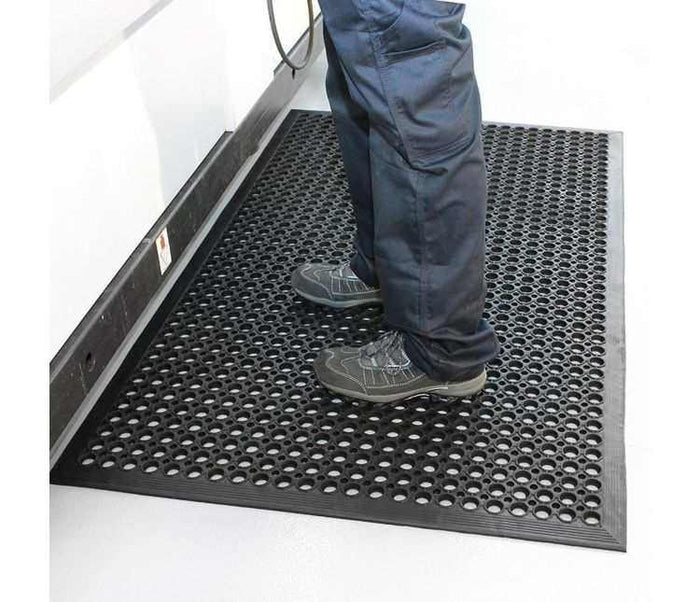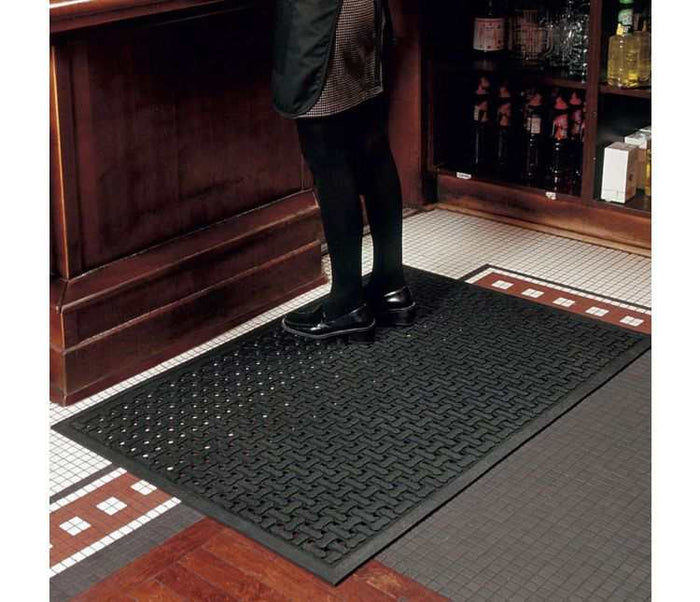Winter in the UK brings picturesque landscapes, but it also ushers in a significant hazard: ice. For businesses and homeowners alike, preventing slips and falls on icy surfaces is not just about avoiding minor inconveniences; it's about safeguarding lives, preventing serious injuries, and fulfilling legal responsibilities. Each year, thousands of individuals suffer injuries from slips on ice, leading to costly medical bills, lost workdays, and potential legal claims. The good news is that with proactive planning and the right tools, these incidents are largely preventable. This comprehensive guide will equip you with seven essential strategies to combat ice, ensuring safer footpaths, driveways, and entrances throughout the colder months.
We'll delve into practical, actionable advice, from choosing the right matting to implementing effective gritting regimes and understanding the importance of proper drainage. Our aim is to help you create an environment where everyone can navigate icy conditions with confidence, protecting both your premises and the people who use them.
Table of Contents
- Understanding the Risks and Responsibilities
- Implement an Effective Gritting and Salting Regime
- Install High-Performance Anti-Slip Matting
- Ensure Proper Drainage and Water Run-off
- Improve Lighting in Hazardous Areas
- Promote and Mandate Appropriate Footwear
- Clear Paths and Walkways Regularly
- Utilise Clear Warning Signage
- Employee Training and Awareness
- Frequently Asked Questions
Understanding the Risks and Responsibilities
Before diving into solutions, it's crucial to grasp the severity of the problem. Slips on ice are a leading cause of accidental injury during winter. For businesses, this translates into potential public liability claims, reputational damage, and disruptions to operations if staff are injured. In the UK, the ‘Occupiers’ Liability Act 1957 and 1984 places a duty of care on those who occupy land or property to ensure the safety of lawful visitors and, to a lesser extent, trespassers. This means taking reasonable steps to identify and mitigate hazards, including icy surfaces.
Homeowners also bear a responsibility, albeit generally less formal, to ensure their property's safety for visitors, delivery personnel, and even passers-by on public footpaths adjoining their property. Proactive risk assessment is the first step: identify areas prone to icing, such as shaded pathways, slopes, entrances, and car parks. Understanding where the risks lie allows for targeted and efficient preventative measures.
Implement an Effective Gritting and Salting Regime
Gritting is arguably the most common and effective method for managing ice. However, its success hinges on proper application and timing. Simply scattering some grit after ice has formed is often too late and less effective. A strategic approach is vital.
Timing is Everything
- Pre-treatment: The most effective time to grit is before ice forms. Monitor weather forecasts closely for predicted drops in temperature below freezing. Applying grit when surfaces are still wet but temperatures are falling allows the salt to dissolve and prevent ice from bonding to the surface.
- Morning and Evening: Icy conditions are most prevalent in the early morning and late evening. Regular gritting at these times, especially in high-traffic areas, is crucial.
- After Snowfall: If snow has fallen, clear it first before gritting. Gritting directly onto snow is ineffective as the grit gets diluted and buried, preventing it from reaching the surface where it needs to work.
Choosing the Right Grit
Not all gritting materials are created equal. Rock salt (sodium chloride) is the most common and cost-effective. However, consider its impact on the environment, vegetation, and hard surfaces over time. Alternative de-icers exist, such as magnesium chloride, which works at lower temperatures and is less corrosive, or grit made from sustainable materials like crushed shells, which provide abrasive grip without chemical impact.
For heavy footfall areas, a mix of grit and sharp sand can provide immediate traction while the salt works to melt the ice. Ensure you have adequate storage for your chosen grit, keeping it dry and easily accessible.
Install High-Performance Anti-Slip Matting
While gritting handles widespread areas, anti-slip matting provides a targeted, continuous layer of protection right where people step – especially at entrances and transition zones. This is particularly crucial for businesses where first impressions and customer safety go hand-in-hand. Mats provide an immediate increase in traction and also help scrape snow and ice off footwear, reducing the amount of moisture tracked indoors.

Value Rubber Scraper Mat with Holes
An excellent choice for outdoor entrances, this robust rubber mat features open holes to effectively scrape dirt, snow, and ice from footwear, allowing water to drain through quickly. Its heavy-duty construction ensures durability in challenging winter conditions, providing superior grip and helping to prevent slips right at your doorstep.
Price: £25.00
View ProductWhen selecting mats, look for materials designed for extreme temperatures, with excellent anti-slip properties even when wet or icy. Rubber mats with open holes or aggressive scraping surfaces are ideal for outdoor use, allowing water and melting ice to drain away, preventing puddles from freezing.
Beyond outdoor entrances, consider indoor matting solutions for areas immediately inside the building. Even if outdoor ice is managed, people will inevitably track in some moisture. High-quality absorbent mats can capture this moisture, preventing slips on smooth indoor flooring. These interior mats also serve a dual purpose, keeping your floors cleaner and reducing maintenance.

Comfort Flow Anti Microbial Rubber Mats
While primarily an indoor mat, the Comfort Flow offers excellent anti-microbial properties and superior anti-slip comfort, making it perfect for transitional areas where wet boots might deposit moisture. Its design promotes drainage and provides a safe, comfortable standing surface, mitigating slip risks from tracked-in ice and slush, and maintaining hygiene indoors.
Price: £56.00
View ProductFor a wide range of effective matting solutions, including outdoor and indoor options designed for safety and durability, visit Mats4U.co.uk.
Ensure Proper Drainage and Water Run-off
Poor drainage is a major contributor to ice formation. Puddles that form during the day will inevitably freeze overnight when temperatures drop. Addressing drainage issues can significantly reduce the potential for icy patches.
Inspect Your Premises
- Identify Problem Areas: Walk around your property, especially after rain, to identify areas where water collects and doesn't drain away effectively. These are your prime candidates for ice formation.
- Clear Drains and Gutters: Blocked drains, gutters, and downpipes can cause water to overflow onto pathways. Regular clearing of leaves and debris is a simple yet effective preventative measure.
- Repair and Improve: Consider repairing cracked or uneven paving that allows water to pool. In some cases, improving gradients or installing additional drainage channels might be necessary for long-term solutions. Even small changes, like redirecting a downpipe, can make a big difference.
By preventing water accumulation, you're directly reducing the raw material for ice formation, making your gritting and matting efforts even more effective.
Improve Lighting in Hazardous Areas
Even with the best gritting and matting, poor visibility can render all other efforts less effective. Icy patches, especially black ice, are notoriously difficult to see, particularly in low light conditions. Adequate lighting is essential to help people identify and avoid hazards.
Strategic Lighting Placement
- Entrances and Exits: Ensure these critical areas are brightly lit. Motion-sensor lights can be a cost-effective solution for areas that don't require constant illumination.
- Pathways and Car Parks: These areas should have sufficient ambient lighting to reveal uneven surfaces and potential ice spots. Consider installing or upgrading lighting fixtures to provide better coverage.
- Stairs and Ramps: These are high-risk areas. Additional task lighting can highlight treads and slopes, significantly reducing the risk of slips.
Regular maintenance of lighting fixtures is also important. Replace burnt-out bulbs promptly and ensure light sources are clear of obstructions like overgrown foliage. Good lighting isn't just about preventing slips; it also enhances overall security.
Promote and Mandate Appropriate Footwear
While property owners have a duty of care, individuals also play a role in their own safety. Encouraging or, for employees, mandating appropriate winter footwear can drastically reduce slip incidents. This is especially true for staff whose roles involve working outdoors or traversing icy car parks.
Key Features of Safe Winter Footwear
- Good Tread: Soles with deep, multi-directional treads offer superior grip on slippery surfaces compared to smooth-soled shoes.
- Material: Rubber or synthetic soles tend to provide better traction on ice than hard leather.
- Ankle Support: Boots with good ankle support can help prevent sprains and fractures in case of a slip.
- Waterproof: Keeping feet dry prevents discomfort and reduces the risk of cold-related injuries.
For businesses, consider issuing guidelines or a policy on footwear during winter months. For homeowners, simply communicating the importance of appropriate shoes to family and guests can be beneficial. Remember, even the best gritting and matting can be compromised by inappropriate footwear.
Clear Paths and Walkways Regularly
Beyond gritting, the physical removal of snow and ice is a fundamental step. This requires diligence and the right equipment.
Effective Clearing Techniques
- Shovel Early and Often: The easiest snow to clear is fresh, light snow. Shovel paths as soon as possible after snowfall, rather than waiting for it to compact or melt and refreeze.
- Target High-Traffic Areas: Prioritise entrances, emergency exits, public footpaths, and key walkways.
- Proper Equipment: Invest in sturdy shovels, ice scrapers, and potentially snow blowers for larger areas. Ensure equipment is well-maintained and easily accessible.
- Where to Put Snow: Pile snow in areas where it won't melt back onto paths and refreeze. Avoid blocking drains or fire exits.
Regular clearing not only removes the immediate hazard but also prevents snow from compacting into slippery ice, which is much harder to remove. This proactive approach significantly enhances safety.
Utilise Clear Warning Signage
Despite all preventative measures, completely eliminating the risk of ice can be challenging during severe winter conditions. In such instances, clear and visible warning signage becomes a critical safety tool.
Effective Signage Strategies
- Placement: Position 'Caution: Ice' or 'Slippery Surface' signs prominently at all entry points, transition zones (e.g., from car park to building entrance), and any areas where ice is particularly difficult to manage.
- Visibility: Ensure signs are highly visible, using bright colours and clear text. Consider reflective or illuminated signs for low-light conditions.
- Timeliness: Deploy signs only when necessary and remove them once the hazard has passed. Overuse or leaving signs out unnecessarily can lead to 'sign blindness,' where people ignore them.
- Language: Use simple, unambiguous language. Pictograms can also be effective, especially for a diverse public.
Warning signs serve as a vital last line of defence, alerting individuals to residual risks and encouraging them to proceed with caution. They also demonstrate a commitment to safety, which can be important for legal due diligence.
Employee Training and Awareness
For businesses, your staff are your first line of defence against winter hazards. Proper training and fostering a culture of awareness can significantly enhance your overall ice prevention strategy.
Key Training Components
- Risk Identification: Train employees to identify potential icy areas and report them. Empowering staff to spot and communicate hazards ensures quicker response times.
- Gritting Procedures: If employees are responsible for gritting, ensure they are thoroughly trained on correct application techniques, timing, and storage of materials. Provide clear instructions on which areas to prioritise.
- Equipment Use: Provide training on the safe and effective use of snow shovels, scrapers, and any other equipment.
- Footwear Policy: Reiterate the importance of appropriate winter footwear and any company policies related to it.
- Reporting Incidents: Establish a clear procedure for reporting slips, trips, or near-misses. This data is invaluable for identifying recurring problem areas and refining your safety plan.
- Personal Safety: Remind employees of safe walking techniques on icy surfaces (e.g., small, shuffling steps, keeping hands free).
Regular communication, perhaps through internal newsletters or safety briefings, can keep winter safety top of mind for everyone. A well-informed and engaged workforce is a safer workforce.
Conclusion
Preventing slips on ice in the UK requires a multi-faceted and proactive approach. There's no single magic bullet; rather, it's a combination of diligent planning, appropriate equipment, and consistent effort. By implementing an effective gritting strategy, installing high-performance matting, addressing drainage issues, ensuring adequate lighting, promoting safe footwear, regularly clearing paths, utilising clear warning signs, and educating your workforce, you can significantly reduce the risk of slips and falls.
Taking these steps not only protects individuals from injury but also shields businesses from potential liability and maintains a positive, safe environment for everyone. Don't wait for the first frost to take action; plan ahead and make winter safety a priority. Explore a comprehensive range of solutions for your winter safety needs at Mats4U.
Frequently Asked Questions
Q: How often should I grit my premises to prevent ice?
A: The frequency of gritting depends on weather conditions. Ideally, grit before ice forms, when temperatures are predicted to drop below freezing and surfaces are wet. In prolonged cold snaps, gritting once or twice a day (early morning and late evening) is often necessary, especially in high-traffic areas. Always re-grit after heavy snowfall or rainfall followed by freezing temperatures, as the salt can be washed away or diluted.
Q: What is the difference between rock salt and de-icer?
A: Rock salt (sodium chloride) is the most common form of grit. It works by lowering the freezing point of water. De-icer, often containing blends of magnesium chloride, calcium chloride, or urea, typically works at lower temperatures than rock salt and can be less corrosive to some surfaces. De-icers are generally more expensive but can be more effective in extreme cold and on sensitive surfaces.
Q: Can anti-slip mats be left out all winter?
A: Yes, high-quality outdoor anti-slip mats, particularly those made from durable rubber, are designed to withstand harsh winter conditions, including freezing temperatures and heavy footfall. Mats with open holes are particularly effective as they allow water and melting ice to drain through, preventing pooling and refreezing on the mat's surface. Regular cleaning to remove accumulated debris will help maintain their effectiveness.
Q: Am I legally responsible if someone slips on ice on my property in the UK?
A: Under the Occupiers' Liability Acts (1957 and 1984), occupiers of premises in the UK have a duty of care to ensure the safety of lawful visitors and, to a certain extent, even trespassers. This means taking 'reasonable steps' to identify and mitigate hazards, including icy surfaces. If you have not taken reasonable steps to prevent slips (e.g., gritting, clearing paths, using mats), you could be found liable. It's about demonstrating due diligence and a proactive approach to safety.
Q: What is 'black ice' and why is it so dangerous?
A: Black ice is a thin coating of ice on a surface, typically roads or pavements. It's dangerous because it's transparent, blending in with the black surface underneath, making it extremely difficult to see. It offers almost no traction, leading to unexpected and sudden slips. Black ice often forms when light rain falls onto a freezing surface or when melted snow refreezes in colder, shaded areas. It highlights the importance of good lighting and cautious walking.
Q: How can I make my property more environmentally friendly when managing ice?
A: To be more environmentally friendly, consider using de-icing alternatives that are less harmful to plants and aquatic life, such as calcium magnesium acetate (CMA) or certain types of grit made from organic materials. Focus on strategic gritting rather than overuse. Improve drainage to reduce the need for de-icing agents, and always clear snow manually before gritting to minimise the amount of salt required. Using highly effective matting also reduces reliance on chemical de-icers.
Stay connected and follow us for more safety tips and product updates!
Find us on Facebook
Connect with us on LinkedIn









